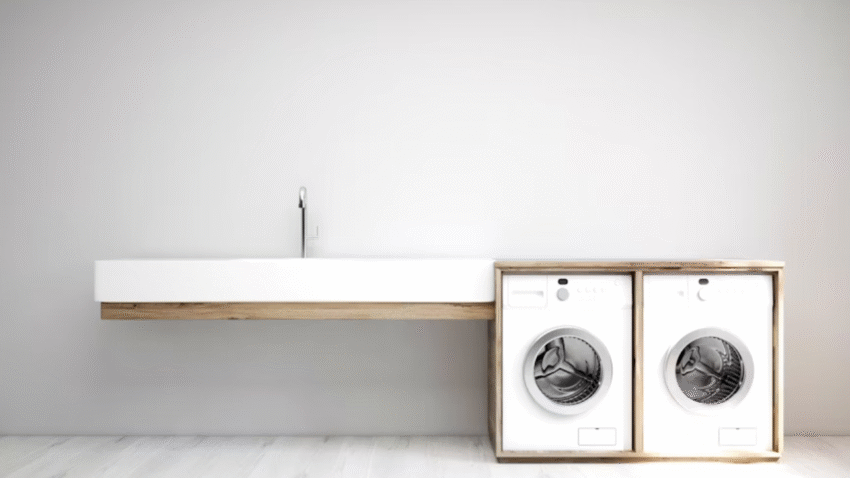Introduction
If your washer and dryer live in a garage, cold weather can be their biggest enemy. Freezing temperatures can cause water lines to burst, damage pumps, and shorten the life of your machines. Knowing how to winterize a washer and dryer in a garage protects your investment, prevents costly repairs, and keeps your laundry appliances ready to go when you need them.
This guide will walk you through the exact steps to prepare your laundry setup for winter—safely and effectively.
Why Winterizing Matters for Garage Laundry Appliances
Unlike laundry rooms inside your home, garages are often unheated and exposed to fluctuating temperatures. This can lead to:
- Frozen water hoses and burst pipes
- Cracked pumps or valves in washers
- Condensation damage inside dryers
- Rust and corrosion on exposed metal parts
By winterizing, you:
- Protect hoses, pumps, and valves from freezing
- Extend the life of your washer and dryer
- Avoid costly emergency plumbing repairs
- Keep your laundry appliances clean and ready for use
Step-by-Step Guide to Winterizing a Washer and Dryer in a Garage
1. Unplug and Disconnect Power
- Always unplug both appliances before working on them.
- For gas dryers, shut off the gas valve and disconnect the line (cap the end for safety).
- Pull both units slightly away from the wall for easier access.
2. Shut Off the Water Supply
- Locate the hot and cold water shut-off valves connected to your washer.
- Turn both valves clockwise to stop water flow.
- If you have a main water supply shut-off for the garage, consider turning that off as well.
3. Drain the Washer Completely
A. Empty the Drum
- Run a short spin cycle to remove any standing water in the drum.
B. Drain Hoses and Pump
- Disconnect the hot and cold water hoses from the back of the washer.
- Drain remaining water into a bucket.
- Remove the washer’s drain hose from the wall standpipe and lower it into a bucket to let water flow out.
C. Protect the Pump with RV Antifreeze
- Pour 1 quart of non-toxic RV antifreeze into the drum.
- Run the washer on a short “drain” or “spin” cycle for 30 seconds to circulate antifreeze through the pump and hoses.
Tip: Use only RV or marine antifreeze—never automotive antifreeze, which is toxic.
4. Dry Out the Washer
- Wipe the drum, gasket, and detergent drawer with a dry cloth.
- Leave the door slightly open to allow airflow and prevent mold growth.
5. Prepare the Dryer
A. Clean the Lint Trap and Vent
- Remove the lint screen and wash with warm, soapy water to remove residue.
- Vacuum lint from inside the trap housing.
- Disconnect the dryer vent hose and clear lint with a vent brush or vacuum.
B. Protect Against Moisture
- Wipe the inside of the dryer drum with a cloth dampened with a vinegar-water solution to prevent mildew.
- Leave the door slightly open to allow air circulation.
6. Prevent Rust and Rodents
- Wipe all exterior surfaces with a microfiber cloth and a mild cleaning solution.
- Spray a light coating of appliance-safe rust inhibitor on exposed metal parts.
- Place rodent deterrents (such as dryer sheets or peppermint oil cotton balls) inside the garage near hoses and vents—mice love warm appliance cavities.
7. Add Extra Insulation (Optional but Recommended)
- Install an insulated washer/dryer cover designed for garage use.
- Use pipe insulation on exposed water hoses and supply lines.
- If possible, add a small space heater with a thermostat to keep the garage above freezing (safety first—never leave unsafe heaters unattended).
8. Reconnect in Spring
When warmer weather returns:
- Remove antifreeze by running an empty rinse cycle.
- Reconnect water hoses and check for leaks.
- Plug in appliances and test with a small load before resuming regular use.
Common Mistakes to Avoid
- Using Automotive Antifreeze
- Highly toxic and unsafe for appliances that touch clothing. Always use RV/marine antifreeze.
- Skipping the Drain Step
- Even a small amount of water in hoses or pumps can freeze and crack components.
- Leaving Doors Closed
- Trapped moisture causes mold and musty odors during winter storage.
- Ignoring the Vent Duct
- Lint buildup is a fire hazard. Clean before winter storage.
- Not Labeling Disconnected Hoses
- Mark which hose is hot and cold for quick reinstallation in spring.
Extra Laundry Room Tips & Hacks
- Monthly Check – Even in winter storage, peek inside your appliances once a month to ensure no rodents or moisture are present.
- Seal Wall Penetrations – Use expanding foam or caulk around hose and vent openings to block drafts and pests.
- Dehumidifier Bonus – If your garage is prone to dampness, a small dehumidifier can prevent rust and mold.
- Quick-Use Option – If you still need occasional winter laundry, use heated hoses and keep a portable space heater nearby during operation.
For more cold-weather care, check out our guide on How to Prevent Mold in a Washing Machine—especially useful when appliances sit unused for long periods.
Conclusion
Knowing how to winterize a washer and dryer in a garage protects your appliances from freezing damage, mold, and rust during cold months. By draining the washer, adding RV antifreeze, cleaning the dryer, and adding insulation, you’ll be ready to store them safely until spring.
📌 Extra Tip: Set a reminder each fall to winterize before the first hard freeze. This simple habit could save you hundreds in repairs and keep your laundry machines running for years to come.
